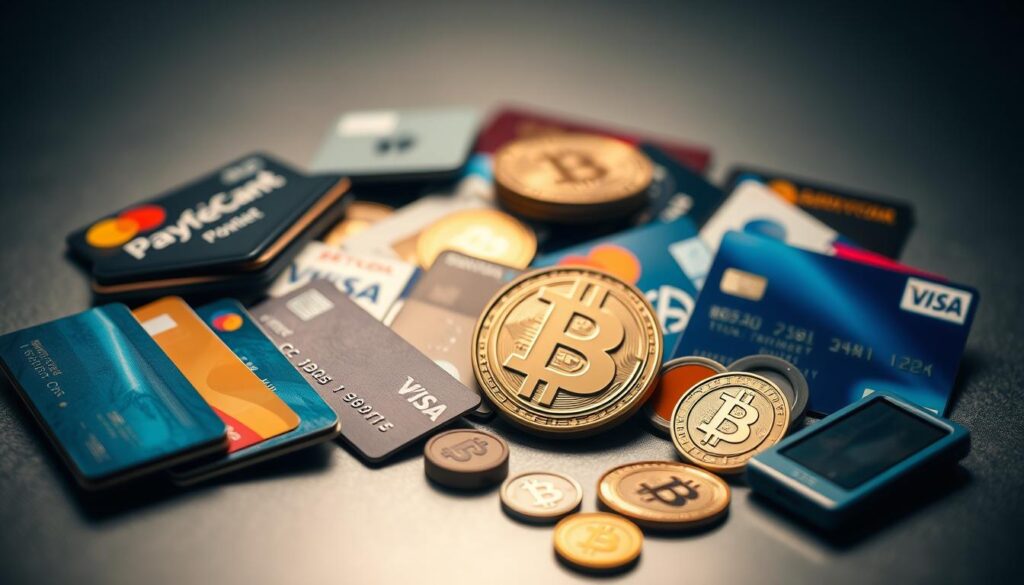In today’s fast-paced digital landscape, having control over your finances is more important than ever. As a small business owner, navigating the world of payment methods can be overwhelming, but it doesn’t have to be. At Revolution Money Exchange, we understand the challenges you face and are here to help you take charge of your financial future.
Our trusted community is dedicated to providing you with the insights, tools, and resources you need to make informed decisions about the best payment methods for your business. Whether you’re just starting out or looking to streamline your existing payment processes, we’ve got you covered.
With the rise of mobile wallets, autopay subscriptions, and other convenient payment options, customers expect quick and easy online purchases. In fact, global consumers spent nearly $1 trillion via mobile payments in 2022, and analysts at Spherical Insights & Consulting expect this figure to triple by 2032. To stay competitive, businesses must be able to accept payments in various formats to cater to different customer preferences.
From credit and debit cards to emerging options like Buy Now, Pay Later (BNPL) and cryptocurrency, the payment methods landscape is constantly evolving. Understanding the pros and cons of each option is crucial for making smart decisions that benefit your business and your customers. We’ll explore the most popular payment methods, their associated fees, and key considerations to help you choose the right solutions for your unique needs.
Key Takeaways:
- 82% of Americans already use digital payments, including PayPal, Venmo, Zelle, and mobile wallets.
- Credit card fees can be as high as 3.5% of the purchase price, while debit card fees typically stay around 1% or less.
- BNPL services often charge retailers higher percentages (2-8%) compared to credit card fees.
- Bank transfers, such as wire transfers, can have fees ranging from $15 to $50, making them less suitable for small purchases.
- Businesses should invest in a Point of Sale (POS) system that can handle multiple digital payment methods.
The Most Popular Payment Methods for Online and In-Store Transactions
In today’s digital age, consumers have access to a wide range of payment methods for both online and in-store transactions. From traditional cash and credit cards to emerging mobile wallets, each payment method offers its own set of benefits and limitations. Let’s explore some of the most popular types of payment methods online and offline.
Credit and Debit Cards: Convenient but with Processing Fees
Credit and debit cards are among the most widely used payment methods, particularly for online purchases. In the United States, 52% of consumers have used a debit card online in the last year, while 47% reported using a credit card. The convenience of these payment methods is unmatched, allowing customers to make purchases with just a few clicks. However, merchants must contend with processing fees ranging from 1% to 3.5% of the purchase price, which can eat into their profits.
Cash Payments: Simple yet Impractical for Online Retailers
Despite the rise of digital payment options, cash remains a popular method of payment, especially for in-store transactions. In fact, 30% of US consumers prefer to use cash, with around 25 to 30% of all transactions being made with physical currency. While cash payments are simple and straightforward, they pose several challenges for businesses. Keeping large amounts of cash on site makes merchants vulnerable to theft, and accepting cash payments is largely impractical for online retailers.
Mobile Wallets: Growing in Popularity but with Limitations
Mobile wallets, such as Apple Pay and Google Pay, are gaining traction as a convenient and secure payment method. An estimated 150 million Americans currently use a digital wallet or have used one in the past. As Josh Guthrie notes, “mobile wallets have taken up to 15 percent share of checkout almost immediately and upwards.” However, merchants may need to invest in new point-of-sale terminals to accept these types of online payment methods, which can be a barrier to adoption.
When choosing the best payment method for your business, it’s essential to consider factors such as transaction fees, security, and customer preferences. By offering a variety of payment options, you can cater to a wider customer base and improve the overall shopping experience.
Emerging Payment Options Gaining Traction
As technology continues to advance, new forms of online payment are emerging and gaining popularity among consumers and businesses alike. These innovative payment methods offer convenience, flexibility, and enhanced security, catering to the evolving needs of the digital marketplace.
One of the most popular payment methods that has gained significant traction in recent years is Buy Now, Pay Later (BNPL). This flexible financing option allows customers to purchase products or services and pay for them in installments over time, often with no interest charges. BNPL has become increasingly attractive to consumers, especially younger generations, who prefer the convenience and affordability it offers compared to traditional credit cards.
Buy Now, Pay Later (BNPL): Flexible Financing for Customers
BNPL services, provided by companies like Affirm, Afterpay, and Klarna, have seen a surge in adoption rates. These different online payment methods enable customers to spread out their payments over several weeks or months, making larger purchases more manageable. Merchants benefit from increased sales and average order values, as customers are more likely to complete purchases when given flexible payment options.
Statistics show that offering a 1% discount for high-value e-commerce purchases can increase pay-by-bank adoption from 20% to 67%. Additionally, improved user interface design can lift pay-by-bank selection during a bill pay check-out flow from 39% to 72%. These figures demonstrate the growing demand for alternative payment methods like BNPL.
Cryptocurrency: Decentralized Digital Currencies on the Rise
Another emerging payment option that has garnered attention is cryptocurrency. Decentralized digital currencies, such as Bitcoin and Ethereum, offer a secure and transparent way to conduct transactions without the need for intermediaries like banks. While the adoption of cryptocurrency as a mainstream payment method is still limited, it has gained a foothold among tech-savvy consumers and businesses looking for alternative forms of online payment.
Many digital wallets, such as those provided by fintech platforms like Venmo and Cash App, now support cryptocurrency transactions alongside traditional payment methods. This integration allows users to seamlessly switch between different payment options, depending on their preferences and the merchant’s acceptance.
As the payments landscape continues to evolve, it is clear that emerging payment options like BNPL and cryptocurrency are reshaping the way consumers and businesses transact. By staying abreast of these trends and incorporating popular payment methods into their offerings, merchants can cater to the diverse preferences of their customers and remain competitive in the ever-changing digital marketplace.
Traditional Payment Methods Still in Use
While newer digital payment options are gaining popularity, traditional ways of making payment remain in use for certain transactions. These time-tested methods, such as checks and bank transfers, offer familiarity and security for some customers and businesses.
Checks: Secure but Time-Consuming and Prone to Fraud
Despite the rise of digital payment methods, some customers still prefer to pay with paper checks. Checks can be a practical way to send payments via mail, especially for larger amounts. However, processing checks can be time-consuming for businesses, and there is always the risk of fraud or bounced checks. Merchants must invest in check processing terminals to verify funds and avoid losses.
Bank Transfers: Ideal for Large Purchases but Impractical for Small Transactions
Bank transfers, including Automated Clearing House (ACH) and wire transfers, are secure ways to make payments without incurring percentage-based commissions. These methods are well-suited for large purchases or business-to-business transactions. However, bank transfers can be impractical for everyday purchases due to processing times and fees.
| Payment System | Characteristics |
|---|---|
| ACH | Processes transactions in batches, may involve delayed settlement and settlement risk |
| RTGS | Settles transactions instantly and irrevocably, used for high-value and urgent transactions |
| Real-time/Instant Payment Systems | Allow transactions to take place within 10-15 seconds |
When choosing the most common payment method for your business, consider factors such as transaction size, customer preferences, and processing costs. While traditional payment methods like checks and bank transfers may not be the best payment options for all situations, they still play a role in the diverse landscape of ways to make payments.
Subscription-Based Payment Models
As businesses continue to evolve, subscription-based payment models have gained significant traction, offering convenience for customers and predictable revenue streams for companies. These models encompass various online payment methods, including credit cards, debit cards, and bank transfers, providing a comprehensive list of bank payment methods to suit different preferences.
Subscription businesses have experienced remarkable growth, with revenues increasing nearly five times faster than S&P 500 companies from 2012 to 2022, according to research from Zuora and the Subscription Economy Index. This trend highlights the growing popularity and effectiveness of subscription-based payment models across industries.
Autopay: Convenient for Recurring Payments and Subscriptions
Autopay systems have emerged as a popular solution for recurring payments and subscriptions. By automatically debiting a customer’s bank account, credit card, or debit card on a set date, usually once per month, autopay promotes customer retention and prevents missed payments for essential bills and subscriptions. This all payment method approach streamlines the process for both businesses and consumers, ensuring a seamless transaction experience.
Membership Pricing: Cost-Effective for High-Volume Businesses
Membership-style pricing, like that offered by Stax, provides high-volume businesses with access to lower interchange-plus fees, making the monthly subscription cost worthwhile in the long run. This pricing model is particularly beneficial for businesses with a large customer base and consistent transaction volumes, as it allows them to optimize their payment processing costs.
When considering subscription-based payment models, businesses have several options to choose from, including:
- Fixed recurring subscriptions (e.g., Netflix)
- Ramp subscriptions with increasing amounts for different service levels (e.g., business software plans)
- Quantity-based subscriptions based on the number of users (common in B2B SaaS companies)
- Usage-based subscriptions where customers pay for actual usage (used by utility providers and digital services like AWS)
To effectively handle subscription payments, businesses can leverage tools like Stripe Billing, which automates billing cycles, ensures secure storage of payment information, and facilitates transaction processing through a payment gateway and processor. By implementing robust subscription payment solutions, businesses can streamline their operations and provide a seamless experience for their customers.
Key Considerations When Choosing a Payment Gateway
When selecting a payment gateway for your business, there are several crucial factors to consider. With e-commerce sales projected to surpass $6.3 trillion by 2024, it’s essential to choose a gateway that aligns with your business needs and customer expectations. One key aspect is the pricing structure, which should strike a balance between subscription fees and transaction fees while being transparent about any hidden costs or minimum monthly charges.
Seamless integration with your existing systems and the ability to customize the checkout experience are also vital. Look for payment gateways that offer a wide range of different online payment methods, as 6% of e-commerce customers abandon their carts due to a lack of suitable ways to make payments. Providing a diverse list of bank payment methods and ways of making payment can significantly reduce cart abandonment and boost sales.
Security should be a top priority when handling sensitive customer data. Ensure that the payment gateway you choose employs robust encryption technology and is PCI compliant. Additionally, consider whether you prefer on-site or off-site transaction processing, as each option has its pros and cons.
With e-commerce expected to account for nearly 25% of global retail sales by 2026, reliable customer support is paramount. Payment gateways like Stripe, which supports over 135 currencies, enable businesses to accept payments in most global markets. Real-time transaction processing and built-in fraud detection tools are also valuable features to look for in a payment gateway.
Ultimately, the right payment gateway should align with your business’s transaction volume, target audience, and the nature of your products or services. By carefully evaluating these key considerations, you can streamline your operations, enhance customer satisfaction, and unlock the full potential of your online sales.
Pricing and Fees: Understanding the Costs Involved
When choosing the best payment options for your business, it’s crucial to understand the various costs associated with each method. While some payment gateways may seem attractive due to their low upfront costs, hidden fees can quickly add up, eating into your profits. Let’s take a closer look at the pricing structures and fees involved in popular payment methods.

Payment gateway costs typically include subscription fees, which can range from $25 to $50 per month on average, and payment processing fees, which are usually around 2.9% + $0.30 per transaction. Some payment portals forgo monthly fees but charge higher transaction fees to compensate. It’s essential to consider the full range of potential fees when evaluating pricing, including:
- Setup fees
- Minimum monthly fees
- Chargeback fees
- Refund fees
- International transaction fees
Subscription Fees and Transaction Fees: Finding the Right Balance
Striking the right balance between subscription fees and transaction fees is key to optimizing your payment processing costs. For businesses with high transaction volumes, a gateway with higher monthly fees but lower transaction fees may be more cost-effective in the long run. On the other hand, businesses with fewer transactions may benefit from a gateway with no monthly fees but slightly higher transaction fees.
| Payment Gateway | Subscription Fee | Transaction Fee |
|---|---|---|
| Stripe | No monthly fee | 2.9% + $0.30 |
| PayPal | No monthly fee | 2.9% + $0.30 |
| Square | No monthly fee | 2.6% + $0.10 |
Hidden Fees and Minimum Monthly Fees: What to Watch Out For
When comparing the most common payment method options, be on the lookout for hidden fees that can quickly add up. Some payment gateways charge minimum monthly fees, which can be problematic for businesses with inconsistent sales volumes. Other potential hidden fees include chargeback fees, refund fees, and PCI compliance fees. Thoroughly review each gateway’s pricing structure to avoid surprises down the line.
By carefully considering the pricing and fees associated with different payment methods, you can select the best payment options for your business, ensuring that you keep more of your hard-earned profits while providing your customers with convenient and secure payment options.
Integrations and Customization Options
When selecting a payment gateway, it’s crucial to consider its integration capabilities and customization options. A well-integrated payment gateway can seamlessly connect with your business’s shopping cart, accounting software, and other essential tools, automating processes and saving valuable time. Customization options, such as adding your company logo or adjusting the color scheme of the payment page, can often be achieved through an API, although not all gateways provide this flexibility.
The most common method of payment gateway integration is via API, which allows for a smooth and secure connection between your website and the payment processor. This approach enables you to maintain control over the checkout experience while ensuring that sensitive customer data is handled securely. Some popular payment gateways, such as Stripe and Authorize.Net, offer robust API integration options.
For businesses with more complex payment processing flows, custom payment integration services may be the best fit. These services cater to medium to large enterprises, retailers, or marketplaces that require tailored solutions to accommodate their unique needs. By opting for a custom integration, you can ensure that your payment gateway seamlessly integrates with your existing systems and processes.
“Over 23 percent of customers abandon their shopping carts due to a complex checkout system or excessive information required to complete the transaction.”
When considering payment method cash options, it’s essential to strike a balance between security and convenience. While hosted payment gateways like PayPal Standard and 2Checkout (now Verifone) redirect customers to a third-party page for payment, integrated gateways such as Stripe and Authorize.Net allow customers to complete the transaction without leaving your website. The latter option requires PCI DSS compliance and places the responsibility of securing and managing card data on your business.
| Payment Gateway | Integration Method | Suitable For |
|---|---|---|
| Stripe | API | Businesses requiring customization and control |
| PayPal Standard | Hosted Payment Page | Small businesses with limited technical resources |
| Authorize.Net | API, Direct Post | Businesses needing flexible integration options |
Ultimately, the right payment gateway integration and customization options depend on your business’s specific needs, technical capabilities, and desired level of control over the checkout process. By carefully evaluating your requirements and comparing the offerings of various payment gateways, you can select a solution that streamlines your payment processing, enhances security, and provides a seamless experience for your customers.
Security Measures to Protect Customer Data
When it comes to online transactions, security is paramount. With the rise of cyber threats and data breaches, it’s crucial for businesses to prioritize the protection of their customers’ sensitive information. By implementing robust security measures, companies can instill trust in their customers and safeguard against potential financial losses and reputational damage.
Encryption Technology and PCI Compliance: Essential for Safeguarding Sensitive Information
One of the most effective ways to secure customer data is through encryption technology. By encrypting sensitive information, such as credit card numbers and personal details, businesses can ensure that even if a data breach occurs, the information remains unreadable to unauthorized parties. Additionally, adhering to the Payment Card Industry Data Security Standard (PCI DSS) is a must for any company that processes, stores, or transmits credit card information.
The importance of these security measures cannot be overstated. In 2022, the average cost of a data breach rose to a staggering $4.35 million, according to IBM reports. Furthermore, the General Data Protection Regulation (GDPR) can impose fines of up to $20 million or 4% of a company’s total global turnover for non-compliance. With data breach incidents increasing by 44% since 2020, and the average cost per incident reaching $15.38 million, the financial implications of inadequate security are clear.
| Security Measure | Importance |
|---|---|
| Encryption Technology | Renders sensitive data unreadable to unauthorized parties |
| PCI Compliance | Mandatory for businesses handling credit card information |
| Regular Software Updates | Protects against known vulnerabilities and exploits |
| Multi-Factor Authentication | Enhances security by requiring multiple forms of identification |
When choosing a payment gateway for your business, it’s essential to consider the various online payment methods available and ensure that the gateway you select offers top-notch security features. Look for providers that utilize the latest encryption technology, are PCI-compliant, and have a proven track record of safeguarding customer data. By prioritizing security, you not only protect your customers but also shield your business from the devastating consequences of a data breach.
“Security is not a product, but a process. It’s about risk management, not risk elimination.” – Bruce Schneier, renowned security expert
In today’s digital landscape, where cyber threats are constantly evolving, businesses must remain vigilant and proactive in their approach to security. By implementing robust measures to protect customer data and staying up-to-date with the latest security practices, companies can instill confidence in their customers and create a safe environment for all payment method transactions.
Payment Methods Supported by Different Gateways
When it comes to selecting a payment gateway for your business, it’s crucial to consider the most popular payment methods supported by each gateway. With over 75 different online payment methods available across 39 listed gateways, businesses have a wide range of options to choose from.
While credit cards like Visa, MasterCard, American Express, and Discover remain the most common payment methods, emerging alternatives such as Apple Pay, Google Pay, UPI, GCash, KaKaoPay, MoMo, OVO, Amazon Pay, PayPal, and PIX are gaining traction. It’s worth noting that Amazon Pay will be deprecated by December 2023, so businesses should plan accordingly.

In addition to credit cards, many gateways support various Direct Debit methods, including SEPA Direct Debit, BACS, Betalingsservice, Autogiro, Direct Entry AU, Direct Debit NZ, and PAD. ACH (Automated Clearing House) is another popular option for bank transfers, with multiple gateways offering this payment method.
Some key statistics to consider when evaluating payment gateways:
- PayPal has the largest market share of 40.78% in payment gateways
- Stripe follows with a 20.10% market share
- Shopify Pay Installments accounts for 13.87% of the market
- Amazon Pay holds a 4.96% market share
Offering multiple payment gateways can provide numerous benefits for businesses, such as:
- Maintaining strategic redundancy to prevent revenue loss due to single points of failure
- Enabling global market penetration by supporting different currencies, regions, and local payment methods
- Employing advanced routing algorithms to select the most cost-effective gateway for each transaction
- Distributing transactions across multiple gateways to increase overall approval rates
- Meeting customer preferences and enhancing the checkout process to improve customer experience and loyalty
When choosing a payment gateway, businesses should carefully consider the popular payment methods supported, as well as factors like client preferences, ease of integration, and fees charged. By selecting the right combination of gateways and payment methods, businesses can optimize their online transaction process and maximize customer satisfaction.
On-Site vs. Off-Site Transactions: Pros and Cons
When it comes to ways to make payments online, businesses must decide between on-site and off-site transaction processing. On-site transactions allow customers to complete their purchase without leaving the business’s website, providing a seamless checkout experience. This option gives businesses greater control over the checkout process, enabling them to customize it to their brand and optimize for conversions.
On the other hand, off-site transactions redirect customers to a separate page, usually hosted by a third-party payment processor like PayPal or Amazon Payments, to enter their payment information. While this method may be simpler to set up, especially for small businesses, it can lead to a higher abandonment rate during checkout. In fact, studies show that a significant proportion of customers leave the site when faced with off-site payments.
Despite the potential drawbacks, off-site payment processing remains a popular choice, particularly for smaller businesses. According to recent data, a high percentage of small businesses opt for off-site payments due to the ease of setup and lower upfront costs compared to implementing on-site payment systems.
For businesses with high sales volumes, however, on-site payment processing is often the preferred option. By keeping customers on their website throughout the entire checkout process, businesses can maintain control over the user experience and potentially boost conversion rates. Additionally, on-site payment processing allows for greater customization and integration with existing systems, making it one of the best payment options for larger enterprises.
Ultimately, the choice between on-site and off-site transactions depends on a variety of factors, including business size, sales volume, and the desired level of control over the checkout process. By carefully weighing the pros and cons of each option, businesses can select the payment processing method that best suits their needs and provides a smooth, secure experience for their customers.
Top Payment Processing Services for Various Business Needs
In today’s digital landscape, businesses have a wide array of payment processing services to choose from, each catering to specific needs and preferences. As the most common payment method evolves, it’s crucial for companies to select a service that aligns with their goals and customer expectations.
One such service is Helcim, which offers interchange-plus credit card processing, a cost-effective solution for businesses with high-volume sales. By providing transparent pricing and competitive rates, Helcim helps companies streamline their payment processes while minimizing costs.
API Customization: Tailored Checkout Experiences for Online Businesses
For businesses seeking a more personalized approach, Stripe’s API customization options allow for the creation of tailored checkout experiences. This flexibility enables companies to integrate payment processing seamlessly into their existing systems, enhancing the overall customer experience.
“Offering multiple payment options can increase customer satisfaction, conversions, and loyalty.”
Shopify’s payment processing service is another popular choice, particularly for businesses already using the platform for their online stores. By integrating directly with Shopify, merchants can streamline their sales process and manage all aspects of their e-commerce operations from a single dashboard.
E-Commerce Platform Integration: Streamlining Online Sales
As businesses navigate the ever-expanding list of bank payment methods and forms of online payment, it’s essential to consider factors such as transaction fees, currency support, and integration capabilities. The following table compares some of the top payment processing services:
| Service | Transaction Fees | Currencies Supported |
|---|---|---|
| PayPal | 3.49% + fixed fee | 25 |
| Stripe | 2.9% + $0.30 | 135+ |
| Square | 2.9% + $0.30 | USD |
| Braintree | 2.59% + $0.49 (cards and digital wallets) | 130+ |
By carefully evaluating their unique requirements and comparing the features and costs of various payment processing services, businesses can select the most suitable option to drive growth and success in the digital marketplace.
Choosing the Right Pay Method for Your Business
Selecting the appropriate payment method is crucial for the success of your business. With a wide array of popular payment methods available, it’s essential to consider various factors to ensure a seamless and secure transaction process for your customers.
When choosing a payment method, take into account your target audience, the nature of your products or services, and the average transaction value. Different demographics may prefer specific payment options, such as younger generations favoring mobile wallets or cryptocurrencies. Aligning your payment methods with your customers’ preferences can lead to increased conversion rates and customer satisfaction.
Evaluate the fees associated with each payment method and how they align with your business’s budget and profit margins. Some popular payment methods, such as credit cards, may have higher transaction fees compared to others. Consider the volume of transactions and the potential impact on your bottom line when making your decision.
| Payment Method | Pros | Cons |
|---|---|---|
| Credit/Debit Cards | Widely accepted, convenient | Higher transaction fees |
| Mobile Wallets | Growing popularity, fast transactions | Limited adoption in some markets |
| Bank Transfers | Ideal for large purchases, lower fees | Slower processing times |
| Cryptocurrencies | Decentralized, global reach | Volatility, regulatory challenges |
Furthermore, consider the user experience and how each payment method will integrate with your existing systems and processes. Offering a smooth and intuitive checkout process can significantly impact customer satisfaction and loyalty. Ensure that the chosen payment gateway provides robust security measures, such as encryption and PCI compliance, to protect sensitive customer data.
Offering the preferred payment methods can help businesses reach more customers globally and capture a larger market share.
By carefully evaluating these factors and understanding your business’s unique requirements, you can select the most popular payment methods that align with your goals and provide a competitive edge in the market.
Conclusion
In today’s fast-paced digital landscape, businesses must adapt to the evolving payment preferences of their customers to stay competitive. From traditional methods like credit cards and bank transfers to innovative solutions such as Buy Now, Pay Later (BNPL) and cryptocurrency, understanding the advantages and disadvantages of each payment option is crucial for making informed decisions. By carefully considering factors like transaction fees, security measures, and integration capabilities when selecting a payment gateway, businesses can create a seamless and secure checkout experience that caters to their customers’ diverse needs.
As technology continues to advance, the ways to make payments are becoming increasingly diverse. Mobile wallets and contactless payments are gaining popularity, offering convenience and speed for both online and in-store transactions. However, traditional payment methods like cash and checks still hold their place in certain industries and among specific demographics. Businesses must strike a balance between embracing new payment technologies and accommodating customers who prefer tried-and-true methods.
Ultimately, the best payment options for a business will depend on its unique needs, target audience, and industry. By staying informed about the latest trends in payment processing and carefully evaluating the costs and benefits of different solutions, businesses can optimize their payment strategies to maximize customer satisfaction and drive growth. Whether it’s implementing a subscription-based model with autopay functionality or accepting cryptocurrency payments, the key is to remain flexible and adaptable in an ever-changing payments landscape.
FAQ
What are the most common payment methods for online and in-store transactions?
What are some emerging payment options gaining popularity?
Are traditional payment methods like checks and bank transfers still in use?
What are the benefits of subscription-based payment models like autopay and membership pricing?
What factors should businesses consider when choosing a payment gateway?
What security measures are essential for safeguarding sensitive customer data?
What are the pros and cons of on-site vs. off-site transactions?
How can businesses choose the right payment method for their specific needs?
Source Links
- 9 Popular Payment Methods and How to Choose One (2024) – Shopify
- 8 Payment Methods And How To Accept Each Payment Mode | Stax Payments
- 4 Payment Methods Most Widely Accepted in the US in 2023
- Top 20 global online payment methods across the world
- Top online payment methods for ecommerce retailers in 2024
- Top 7 Payment Trends To Watch In Payment Processing
- Emerging Payments: Trends, Technologies, and the Future of Transactions
- The future of e-commerce payments | Plaid
- Payment system
- 12 Payment Methods & How to Accept Each Mode of Payment?
- Subscription payment processing 101: A quick guide | Stripe
- Complete Guide to Subscription Payment Gateways (2024)
- 5 factors to consider when choosing the right payment gateway for your e-commerce business
- How to choose a payment gateway | Stripe
- Guide to Payment Types, With Pros and Cons for Each
- Payment gateway fees and pricing | Stripe
- 10 Best Payment Gateway Integrations for Your Online Store
- Payment Gateway Integration Guide
- Custom Integration | Customize Your Checkout
- Customer Data Privacy: 10 Non-Negotiable Best Practices to Protect Your Business | WordStream
- Protect Your Personal Information and Data
- 11 practical ways to keep your IT systems safe and secure
- Overview of payment methods supported by Zuora payment gateway integrations
- How to use multiple payment gateways | Stripe
- What Are Payment Gateways? Definition + How They Work
- Processing Payments: On-Site vs Off-Site
- Payment Gateways in 2024: Main Types + How They Work
- How to choose a payment gateway for your business
- Exploring the Best Method of Payment for Your Business Needs
- The 15 best online payment processing tools for e-commerce | The Jotform Blog
- All Types of Payment Methods Business Owners Need to Know [+Data]
- Top 7 Payment Methods to Consider for Your Business
- A Guide to Types of Payment Methods | Stripe
- 8 Findings and Conclusions | Pay for Performance: Evaluating Performance Appraisal and Merit Pay
- Payment Trends: What are the Options? (Conclusion)
- Methods of Payment



